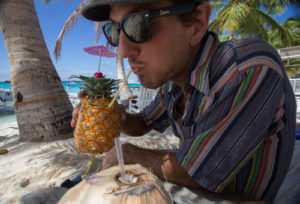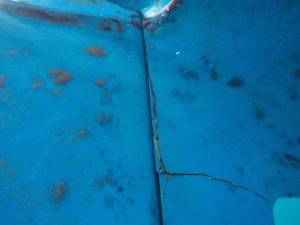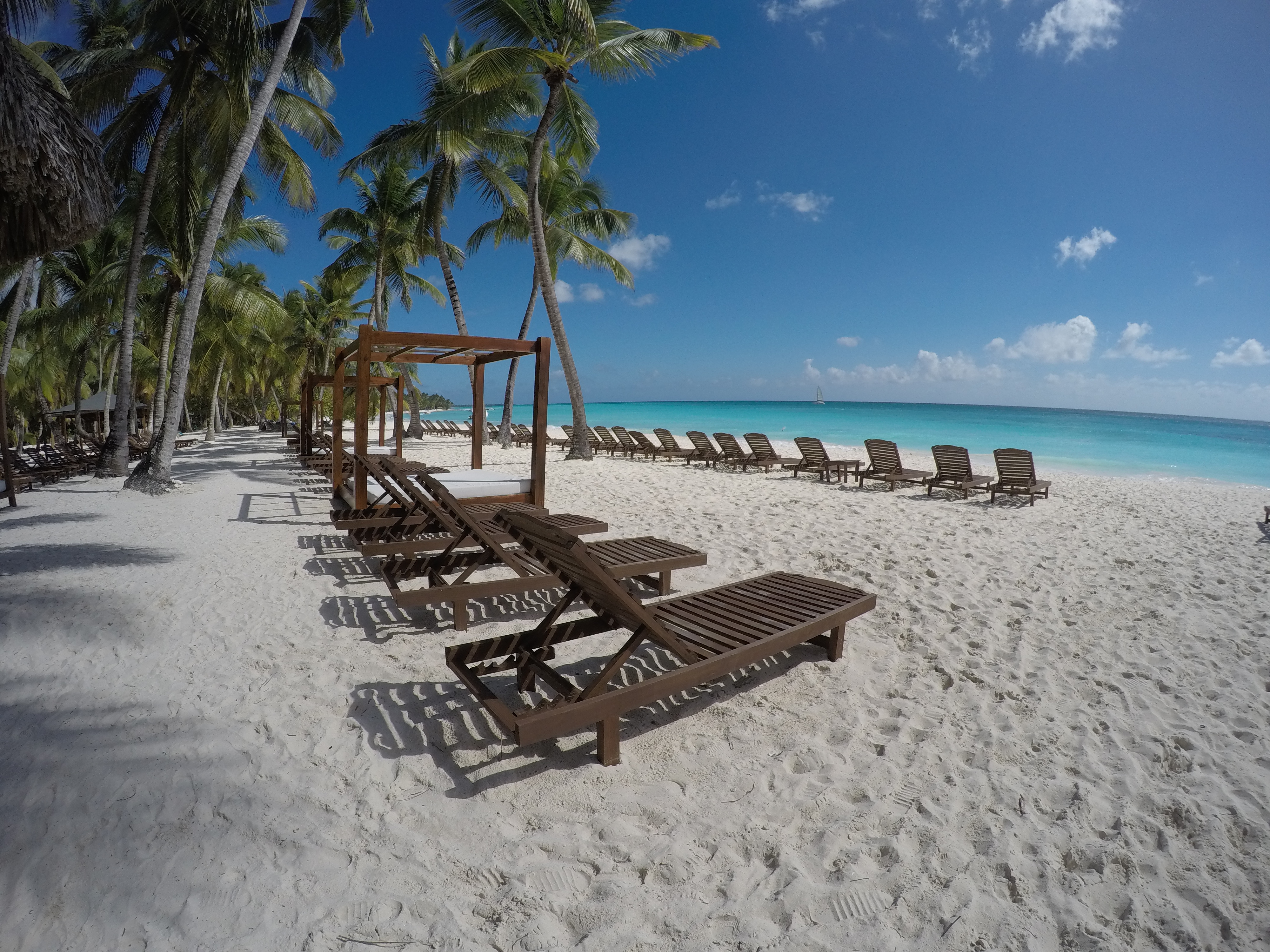We make good progress throughout the night and by sunrise we are anchoring in the lee of Isla Saona. Apparently this island just off the SE coast of the DR is a nationally protected park, but that doesn’t seem to stop some enterprising companies from cashing in on its beauty.
Shortly after getting the boat bedded down and preparing for some much needed sleep ourselves, we notice a whole fleet of sails on the horizon coming our way–not a common sight unless you are in the midst of a regatta. Before long, dozens of massive catamarans pull up beside us and drop anchor while a fleet of local panga boats rush to their sides to ferry piles of pink-skinned tourists ashore. Here they’ll spend the day drinking rum ‘n cokes, eating BBQ chicken, and sun-cooking on the beach before loading up once again to be returned to the mainland by sunset. This routine happens everyday, seven days a week, like clockwork. We know this because we actually spend one week there…nearly all of it stranded on our boat because the dinghy engine refuses to fire and it’s blowing to strong to row ashore.
It just so happens that SeaJay’s birthday passes during this time, but unfortunately not on the one day that I do get the engine to work. But on that day–I choose to think of it as her belated birthday–we do manage to get ashore and pass as “ticket-holding” tourists and join the masses splurging on the free buffets of food and drink.
It’s all a bit surreal though, and mostly I can’t help but gawk at the overwhelming audaciousness of the place, which operates as a well-oiled movie-set for providing the paying customer with a picture-perfect experience of the quintessential tropical holiday. There are palm-thatched tiki-huts everywhere you turn; an uncountable number of recliner sun-chairs with or without starched white umbrellas; pina coladas served in pineapples complete with tiny umbrellas of their own; there’s volleyball courts in the sand, hammocks between palm trees, and straw-punctured coconuts galore. All of this backdropped by turquoise waters with patchwork reef. If you Google image “beach holiday” you will not find a more fitting representation.

Of course if you look close enough or stay a bit after hours (because you don’t have to catch the boat back), then you can see plenty of the “support structure” that makes this all possible. Massive hills of overflowing black garbage bags that must be daily removed from the island; enormous coolers that must be filled in order to keep an ever-ready supply of ice for each beverage; a hodgepodge of electrical wire and plumbing pipes that are haphazardly buried or causally painted-over in attempt to discretely distribute these much needed resources; a “backroad” along which local motorbikes zip, dodging the donkey-pulled wagons and foot-bound workers alike. There are even entire villages, thinly-veiled behind ramshackle fences adorned with palm thatching, where many of the workers live, sometimes for years at a stretch–we find out after speaking with a few later on.

It seems as if the place never sleeps, working from sun-up (we see all of the support vessels bringing fresh supplies and removing garbage as we sip our morning coffee) to well after sun-down (cleaning the beaches, re-straightening the endless lines of beach chairs, and preparing for tomorrow’s cooking). As I say, the whole thing feels like what I imagine being on a movie-set would feel like…only the movie never ends.
Turns out we have some issues with out own support structure…
During our week at “Paradise Island” we finally manage to return to the water, jumping in for a good swim. I even have enough ambition to grab a scraper and commence cleaning the boat bottom. But my work instantly ceases as soon as I discover the greatest menacing horror that any boat-owner hopes to never find…a crack in the hull! This is no tiny hairline thing either, this is a total severance of the fiberglass, a crack that I can easily stick a screwdriver in and pry open to reveal horrifying inner blackness! What the #uck! How and when did this happen? Are we taking on water?

I immediately depart the water and empty our cockpit locker in order to gain access to the adjacent area. All this I attempt to do calmly so as to not alarm my wife, who fortunately is sun-bathing on the bow. I finally gain access to the engine compartment and hold my breath before peering inside with a flashlight. A small puddle of water sits below the prop shaft stuffing box, as it should, but nothing else can be observed. I strain my hears to listen for the sound of trickling water, and pan the light about in search of the reflective sheen of agua…nothing. Phew, well that’s good, but I still want a closer look.
The crack is along the skeg, which as a separate piece from the hull, and therefore thankfully a hole in such will not sink the boat. However, the function of this underwater appendage is to support and protect the rudder and it’s not looking so healthy. I grab hold the bottom of the skeg and give it a good shake (my feeble attempt to replicate the impressive hydrodynamic forces it encounters while we are underway) and observe that—in the words of a former construction coworker—the whole thing is “floppy chicken.”
 I test, observe, and ponder a bit more before concluding that: a) instead of the skeg supporting the rudder; b) the rudder is actually supporting the skeg and probably keeping it from breaking off altogether; c) the rudder is not designed to do this and could be compromised in the process; d) about the only thing worse than taking on unwanted water is a loss of steerage–if you can’t turn your boat than she simply becomes a floating piece of flotsam, entirely subject to the whims of the sea and hopelessly vulnerable; and e) I’ve been in the water so long that I’m bloody freezing.
I test, observe, and ponder a bit more before concluding that: a) instead of the skeg supporting the rudder; b) the rudder is actually supporting the skeg and probably keeping it from breaking off altogether; c) the rudder is not designed to do this and could be compromised in the process; d) about the only thing worse than taking on unwanted water is a loss of steerage–if you can’t turn your boat than she simply becomes a floating piece of flotsam, entirely subject to the whims of the sea and hopelessly vulnerable; and e) I’ve been in the water so long that I’m bloody freezing.
“What about using some underwater epoxy?” Clare will suggest after my nonchalant attempt to inform her of the crisis over dinner, “you know, one of the several tubes you absolutely insisted we buy before departure.” That I did, but I go on to explain that doing such would be like putting a band-aid over a broken bone. Sure you may hide the visibility of the wound, but you are not re-setting the compromised structure. In no time at all the epoxy will simply give-way to the underwater stresses and the bone will continue to remain broken…only now with the wasted time, effort, and product of lumpy epoxy clinging to the edges of it’s fracture.
To uncovering the unwanted.








